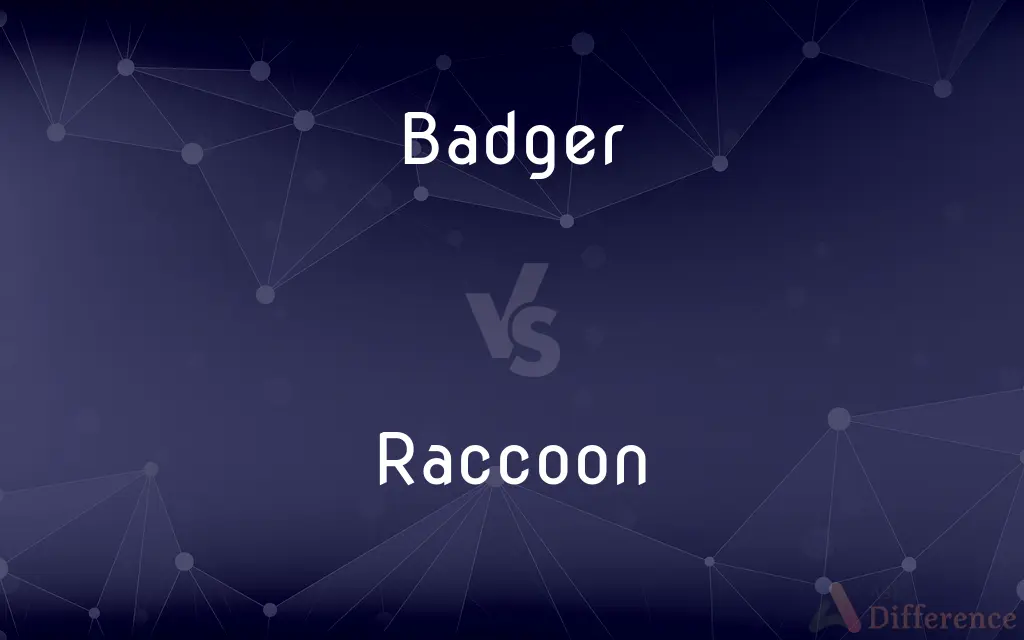Badger vs. Raccoon — What's the Difference?
Edited by Tayyaba Rehman — By Maham Liaqat — Updated on April 8, 2024
Badgers are sturdy, ground-dwelling animals known for their digging abilities, while raccoons are adaptable, omnivorous mammals famous for their dexterous front paws and masked facial markings.

Difference Between Badger and Raccoon
Table of Contents
ADVERTISEMENT
Key Differences
Badgers, belonging to the family Mustelidae, are known for their stocky bodies, short legs, and remarkable digging capabilities, thanks to their strong forelimbs and sharp claws. They have a varied diet that includes worms, insects, and small mammals, reflecting their role as omnivores. Raccoons, on the other hand, are members of the Procyonidae family and are easily recognizable by their black "mask" of fur around their eyes and bushy, ringed tails. They are highly adaptable, living in both rural and urban environments where they often scavenge for food.
Badgers are solitary and territorial animals, living in large underground burrows known as setts, which they dig themselves. Their fur is typically grayish or brown, with distinctive black and white markings on their faces. Raccoons are known for their remarkable manual dexterity, with front paws capable of opening containers and manipulating objects. They have a broad diet that includes fruits, nuts, insects, and small animals, showcasing their omnivorous nature.
In terms of behavior, badgers are primarily nocturnal and spend much of their time underground. They are fierce when threatened and will defend their territories aggressively. Raccoons are also nocturnal but are known for their curiosity and intelligence, traits that help them navigate complex environments and remember food sources. They are excellent climbers and swimmers, skills that badgers, being more terrestrial, do not typically exhibit.
Conservation-wise, most badger species have stable populations but face threats from habitat destruction and persecution. Raccoons, however, have thrived in the face of human expansion, with their populations increasing in many areas, though this has led to conflicts with humans over property damage and the spread of diseases.
Comparison Chart
Family
Mustelidae
Procyonidae
ADVERTISEMENT
Habitat
Forests, grasslands, and farmlands
Wide range, including urban environments
Diet
Omnivorous: worms, insects, small mammals
Omnivorous: fruits, nuts, insects, small animals
Social Behavior
Solitary and territorial
Sociable, can live in communal groups
Physical Traits
Stocky body, strong forelimbs, sharp claws
Dexterous front paws, masked facial markings, ringed tail
Behavior
Nocturnal, spends time underground
Nocturnal, adaptable, good climbers and swimmers
Conservation
Stable but threatened by habitat destruction
Thriving, but conflicts with humans
Compare with Definitions
Badger
Solitary and territorial.
Badgers fiercely defend their territories from intruders.
Raccoon
An adaptable mammal with distinctive masked facial markings.
The raccoon used its dexterous paws to open the trash can.
Badger
Faces threats from habitat destruction.
The badger's natural habitat is diminishing due to urban expansion.
Raccoon
Populations are increasing, leading to human conflicts.
The growing raccoon population has led to more frequent encounters with humans.
Badger
A stocky, digging mammal known for living in underground setts.
The badger used its sharp claws to excavate a burrow.
Raccoon
Thrives in urban environments.
Raccoons have adapted well to city life, often scavenging food from bins.
Badger
Primarily nocturnal.
Badgers are rarely seen during the day as they are nocturnal creatures.
Raccoon
Known for its intelligence and curiosity.
Raccoons are skilled at remembering the locations of food sources.
Badger
Has a varied omnivorous diet.
Badgers forage for worms and insects at night.
Raccoon
Exhibits sociable behavior.
Raccoons can form loose groups when foraging.
Badger
Badgers are short-legged omnivores mostly in the family Mustelidae (which also includes the otters, polecats, weasels, and ferrets), but also with two species called "badgers" in the related family Mephitidae (which also includes the skunks). Badgers are a polyphyletic grouping, and are not a natural taxonomic grouping: badgers are united by their squat bodies, adapted for fossorial activity.
Raccoon
The raccoon ( or US: (listen), Procyon lotor), sometimes called the common raccoon to distinguish it from other species, is a medium-sized mammal native to North America. It is the largest of the procyonid family, having a body length of 40 to 70 cm (16 to 28 in), and a body weight of 5 to 26 kg (11 to 57 lb).
Badger
Any of several carnivorous burrowing mammals of the family Mustelidae, such as Meles meles of Eurasia or Taxidea taxus of North America, having short legs, long claws on the front feet, and a heavy grizzled coat.
Raccoon
An omnivorous mammal (Procyon lotor) native to the Americas and introduced elsewhere, having grayish-brown fur, black masklike facial markings, and a black-ringed bushy tail.
Badger
The fur or hair of any of these mammals.
Raccoon
The fur of this mammal.
Badger
Any of several similar mammals, such as the ratel.
Raccoon
Any of various similar or related animals.
Badger
To ask or nag (someone) about something in an annoying and persistent way; pester
Badgered the boy into cleaning his room.
Raccoon
An omnivorous, nocturnal mammal native to North America, typically with a mixture of gray, brown, and black fur, a mask-like marking around the eyes and a striped tail; Procyon lotor.
Badger
Any mammal of three subfamilies, which belong to the family Mustelidae: Melinae (Eurasian badgers), Mellivorinae (ratel or honey badger), and Taxideinae (American badger).
Raccoon
Any mammal of the genus Procyon.
Badger
A native or resident of the American state, Wisconsin.
Raccoon
Any mammal of the subfamily Procyoninae, a procyonine.
Badger
(obsolete) A brush made of badger hair.
Raccoon
Any mammal of the family Procyonidae, a procyonid.
Badger
A crew of desperate villains who robbed near rivers, into which they threw the bodies of those they murdered.
Raccoon
Any mammal superficially resembling a raccoon, such as a raccoon dog.
Badger
(obsolete) An itinerant licensed dealer in commodities used for food; a hawker; a huckster; -- formerly applied especially to one who bought grain in one place and sold it in another.
Raccoon
A North American nocturnal carnivore (Procyon lotor) allied to the bears, but much smaller, and having a long, full tail, banded with black and gray. Its body is gray, varied with black and white. Called also coon, and mapach.
Badger
To pester; to annoy persistently; to press.
He kept badgering her about her bad habits.
Raccoon
The fur of the North American racoon
Badger
An itinerant licensed dealer in commodities used for food; a hawker; a huckster; - formerly applied especially to one who bought grain in one place and sold it in another.
Raccoon
An omnivorous nocturnal mammal native to North America and Central America
Badger
A carnivorous quadruped of the genus Meles or of an allied genus. It is a burrowing animal, with short, thick legs, and long claws on the fore feet. One species (Meles meles or Meles vulgaris), called also brock, inhabits the north of Europe and Asia; another species (Taxidea taxus or Taxidea Americana or Taxidea Labradorica) inhabits the northern parts of North America. See Teledu.
Badger
A brush made of badgers' hair, used by artists.
Badger
To tease or annoy, as a badger when baited; to worry or irritate persistently.
Badger
To beat down; to cheapen; to barter; to bargain.
Badger
Sturdy carnivorous burrowing mammal with strong claws widely distributed in the northern hemisphere
Badger
Annoy persistently;
The children teased the boy because of his stammer
Badger
Persuade through constant efforts
Common Curiosities
Can both badgers and raccoons be found in urban areas?
Badgers are less commonly found in urban areas compared to raccoons, which thrive in such environments.
How do badgers and raccoons adapt to their environments?
Badgers adapt by digging extensive burrow systems for shelter, whereas raccoons adapt through their intelligence and manual dexterity, allowing them to scavenge and live in a variety of settings.
How do badgers and raccoons defend themselves?
Badgers rely on their physical strength and aggressive nature when threatened, while raccoons use their intelligence and agility to escape predators.
Are badgers social animals like raccoons?
No, badgers are more solitary and territorial, unlike raccoons, which can live in communal groups.
What distinguishes a badger's diet from a raccoon's?
Badgers primarily eat worms, insects, and small mammals, while raccoons have a broader diet that includes fruits, nuts, and small animals.
Which is more nocturnal, a badger or a raccoon?
Both are primarily nocturnal, though this trait is more emphasized in badgers due to their underground living habits.
Why are raccoons considered a problem in urban areas?
Raccoons are often considered pests in urban areas due to their habit of scavenging trash, potential to spread diseases, and causing property damage.
What are the conservation statuses of badgers and raccoons?
Most badger species have stable populations but face habitat destruction threats, while raccoons are generally thriving, though their interactions with humans can be problematic.
How do the physical traits of badgers and raccoons differ?
Badgers are stocky with strong forelimbs for digging, while raccoons have dexterous front paws and are known for their masked facial markings and ringed tails.
What role do badgers and raccoons play in their ecosystems?
Both are important omnivores that help control insect and small mammal populations, with raccoons also playing a role in seed dispersal due to their varied diet.
Can raccoons be kept as pets?
While some people do keep raccoons as pets, it is generally not recommended due to their wild nature, potential health risks, and the complexity of their care.
What makes raccoons particularly adaptable?
Raccoons' adaptability is attributed to their intelligence, curiosity, and manual dexterity, enabling them to navigate and exploit various environments.
Are badgers affected by urban expansion?
Yes, badgers are affected by urban expansion, which encroaches on their natural habitats and reduces the availability of their food sources.
Share Your Discovery

Previous Comparison
Collaboration vs. Communication
Next Comparison
Gram vs. TolaAuthor Spotlight
Written by
Maham LiaqatEdited by
Tayyaba RehmanTayyaba Rehman is a distinguished writer, currently serving as a primary contributor to askdifference.com. As a researcher in semantics and etymology, Tayyaba's passion for the complexity of languages and their distinctions has found a perfect home on the platform. Tayyaba delves into the intricacies of language, distinguishing between commonly confused words and phrases, thereby providing clarity for readers worldwide.














































